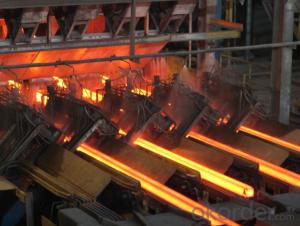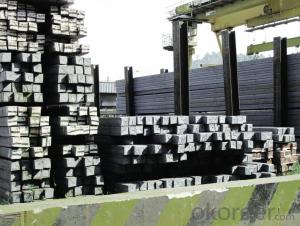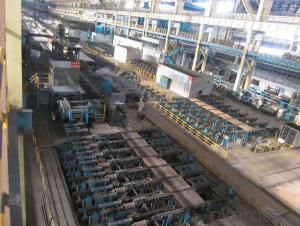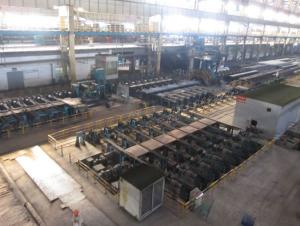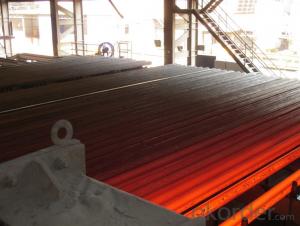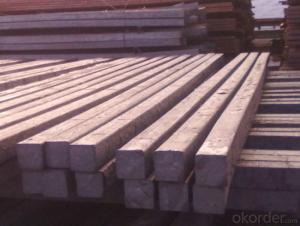Hot Rolled Square Steel Billet 3SP Standard 105mm
- Loading Port:
- Shanghai
- Payment Terms:
- TT OR LC
- Min Order Qty:
- 2000 m.t.
- Supply Capability:
- 10000 m.t./month
OKorder Service Pledge
OKorder Financial Service
You Might Also Like
Structure of Hot Rolled Square Steel Billet 3SP Standard 105mm

Description of Hot Rolled Square Steel Billet 3SP Standard 105mm
PPGI is made by cold rolled steel sheet and galvanized steel sheets as baseplate, through the surface pretreatment (degreasing, cleaning, chemical conversion processing), coated by the method of continuous coatings (roller coating method),
and after roasting and cooling. Zinc coating: Z60, Z80, Z100, Z120, Z180, Z275, G30, G60, G90
Alu-zinc coating: AZ60, AZ80, AZ100, AZ120, AZ180, G30, G60, G90
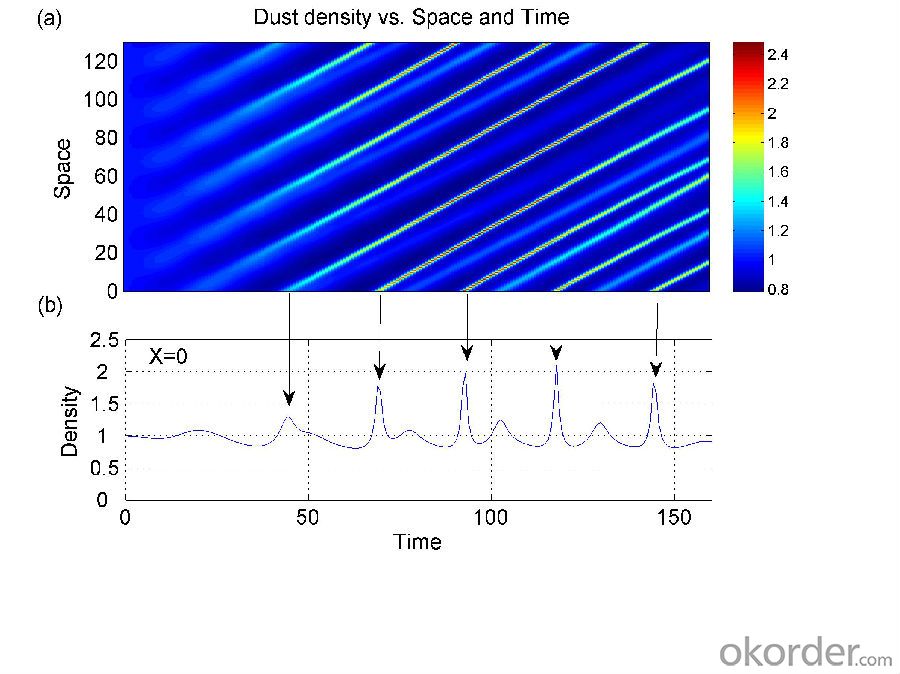
Main Feature of Hot Rolled Square Steel Billet 3SP Standard 105mm
1) Excellent corrosion resistance: The zinc layer provides a good protection of Pre-painted Galvanizeed Steel Sheet.
2) High heat resistance: The reflective surface of the material aids in efficiently reflecting the sunlight away and in turn reducing the amount of heat transmitted. The thermal reflectivity converts into energy savings.
3) Aesthetics: Pre-Painted Galvanized steel sheet is available in plethora of patterns and multiple sizes as per the requirements that given by our customers.
4) Versatility: can be used in the various areas.Standard seaworthy export packing: 3 layers of packing, inside is kraft paper, water plastic film is in the middle and outside GI steel sheet to be covered by steel strips with lock, with inner coil sleeve.
Applications of Hot Rolled Square Steel Billet 3SP Standard 105mm
1) Automotive bodies: filters, fuel tanks, etc.
2) Construction materials: roofings, welding pipes,
3) Electric and electronic appliances: computer cans, etc.
4) Steel cans: containers, etc.
5) Steel furniture: washing machines, refrigerators, microwaves, etc.
6) Drums
7) Office equipment: printer, recorders, etc.
8) Motors and transformers

Specifications of Hot Rolled Square Steel Billet 3SP Standard 105mm
| Classified symbol | Yield Point Minimum N/mm2 | Tensile Strength Minimum | Elongation Minimum % | Application | ||||
| N/mm2 | Nominal Thickness mm (t) | |||||||
| JIS | Yogic | 0.25-0.4 | 0.4-0.6 | 0.6-1.0 | 1.0-1.6 | |||
| G3312 | specification | |||||||
| CGCC | CGCC | -205 | -270 | -20 | -21 | -24 | -24 | Commercial |
| CGCD | CGCD | --- | 270 | --- | 27 | 31 | 32 | Drawing |
| --- | CG340 | 245 | 340 | 20 | 20 | 20 | 20 | Structural |
| CGC400 | CG400 | 295 | 400 | 16 | 17 | 18 | 18 | Structural |
| CGC440 | CG440 | 335 | 440 | 14 | 15 | 16 | 18 | Structural |
| CGC490 | CG490 | 365 | 490 | 12 | 13 | 14 | 16 | Structural |
| CGC570 | CG570 | 560 | 570 | --- | --- | --- | --- | Structural |
| ASTM Designation | Yield Point Minimum | Tensile Strength Minimum | Elongation Minimum % | Application | Q/BQB 445-2004(China standard) | ASM A653/A653M | JISG 3312 | |
| ksi(MPa) | ksi(MPa) | TDC51D+Z | (CS TYPE A+Z) | CGCC | ||||
| A653(M)-99 CS TYPE A,B,C | --- | --- | --- | Commercial | TDC52D+Z | CGCD | ||
| A653(M)-99 FS | --- | --- | --- | Lock Forming | TS250GD+Z | (G250+Z) | - | |
| A653(M)-99 DS | --- | --- | --- | Drawing | TS300GS+Z | (G300+Z) | CGC 400 | |
| A653(M)-99 SS Grade33(230) | 33(230) | 45(310) | 20 | Structural | TS350GD+Z | (G350+Z) | CGC490 | |
| A653(M)-99 SS Grade37(255) | 37(255) | 52(360) | 18 | Structural | TS550GD+Z | (G550+Z) | CGC570 | |
| A653(M)-99 SS Grade40(275) | 40(275) | 55(380) | 16 | Structural | ||||
| A653(M)-99 SS Grade50(345) | 50(345) | 65(450) | 12 | Structural | ||||
| A653(M)-99 SS Grade80(550) | 80(550) | 82(570) | --- | Structural | ||||
FAQ of Hot Rolled Square Steel Billet 3SP Standard 105mm
We have organized several common questions for our clients,may help you sincerely:
1. How Can I Visit There?
Our company is located in Tianjin City, China, near Beijing. You can fly to Tianjin Airport Directly. All our clients, from home or aboard, are warmly welcome to visit us!
2. How Can I Get Some Sample?
We are honored to offer you sample.
3. Why choose CNBM?
1, ISO, BV, CE, SGS approved.
2, Competitive price and quality.
3, Efficient service team online for 24 hours.
4, Smooth production ability(50000tons/month) .
5, quick delivery and standard exporting package.
6, Flexible payment with T/T, L/C, Paypal, Kunlun bank, etc .
- Q:Can steel billets be used in the production of utensils and cutlery?
- Yes, steel billets can be used in the production of utensils and cutlery. Steel billets are typically processed and shaped into various forms such as sheets, bars, or rods, which can then be further manufactured into utensils and cutlery items through processes like forging, casting, or stamping.
- Q:What are the different international standards for steel billets?
- There are several international standards for steel billets, including the American Society for Testing and Materials (ASTM) standards, the International Organization for Standardization (ISO) standards, and the European Committee for Standardization (EN) standards. These standards define the chemical composition, mechanical properties, and dimensions of steel billets, ensuring their quality and compatibility for various industries and applications worldwide.
- Q:How are steel billets straightened after rolling or forging?
- Steel billets may become irregular or bent after the rolling or forging process. To rectify this, several methods can be utilized depending on the size and shape of the billets. One commonly used technique is rotary straightening. In this process, the billets are passed through a series of rotating rolls or wheels that gradually exert pressure on the material, resulting in straightening. The rolls are typically positioned at different angles to evenly distribute force across the billet. This method is suitable for smaller billets or those with minor bends. For larger and thicker billets, hydraulic straightening is often employed. Controlled pressure is applied at specific points along the length of the billet using hydraulic presses or jacks. By adjusting the pressure at different points, the billet is gradually straightened. This method is more appropriate for heavier and significantly bent billets. In certain instances, heat can be used to facilitate the straightening process. Heat straightening involves heating the bent section of the billet to a specific temperature and then applying pressure to straighten it while it is still hot. This method is particularly effective for billets with substantial bends or twists. It is crucial to emphasize that the straightening process necessitates precise control and monitoring to avoid over-straightening or excessive stress on the material. Skilled operators and advanced equipment are indispensable to ensure effective straightening of the billets within the desired tolerances.
- Q:What are the main factors affecting the mechanical properties of steel billets?
- The main factors affecting the mechanical properties of steel billets include the composition of the steel, the heat treatment process, the grain size, and the presence of impurities or defects in the metal.
- Q:How do steel billets contribute to the manufacturing of consumer goods?
- Steel billets play a crucial role in the manufacturing of consumer goods by serving as the raw material for a wide range of products. These billets are essentially semi-finished steel products that are created through the casting process. They are solid blocks of steel that are heated and then shaped into a specific form, which can vary depending on the intended application. One of the primary ways steel billets contribute to the manufacturing of consumer goods is through their use in the production of various metal parts. These parts can be found in a multitude of products, such as automobiles, appliances, machinery, and furniture. By using steel billets as the starting material, manufacturers can create components that are strong, durable, and resistant to wear and tear. This ensures that the final consumer goods have a long lifespan and can withstand the demands of everyday use. Furthermore, steel billets are often used in the construction industry for the production of structural steel beams, columns, and other building materials. These components are crucial for the construction of infrastructure, residential buildings, commercial complexes, and other structures. Steel's high strength-to-weight ratio makes it an ideal material for these applications, providing the necessary structural support while minimizing the overall weight and cost. In addition to their strength and durability, steel billets also offer versatility in terms of their formability and machinability. This means that they can be easily shaped, welded, and cut into various sizes and designs, allowing manufacturers to tailor the steel components to meet specific consumer needs. This flexibility enables the production of a wide range of consumer goods, from small intricate parts to large complex structures. The use of steel billets in the manufacturing of consumer goods also contributes to sustainability. Steel is a highly recyclable material, and the production of steel products using recycled steel requires significantly less energy and resources compared to using virgin materials. This helps reduce the environmental impact associated with consumer goods production and promotes a more circular economy. Overall, steel billets are a crucial ingredient in the manufacturing of consumer goods. Their strength, durability, versatility, and recyclability make them an ideal material choice for producing a wide range of products that meet the needs and expectations of consumers.
- Q:How do steel billets contribute to the aerospace industry?
- The aerospace industry heavily relies on steel billets as they serve as the essential raw material for producing various components and structures used in aircraft. These semi-finished metal forms, created through continuous casting, play a crucial role in the manufacturing process. Once formed, the steel billets undergo further processing using techniques like forging, machining, and heat treatment to transform them into different aerospace components. This allows for the customization of billets into specific forms like engine parts, landing gear components, structural frames, and other critical elements. Utilizing steel billets in the aerospace industry offers numerous advantages. Firstly, steel is renowned for its strength, durability, and exceptional mechanical properties, making it an ideal material for applications that prioritize safety and reliability, such as in the aerospace sector. Steel billets can withstand extreme conditions like high temperatures, pressure, and stress, making them suitable for critical parts that need to perform under demanding circumstances. Moreover, steel billets provide cost-effectiveness and versatility in manufacturing. Steel is readily available and comparatively more affordable than other metals used in aerospace applications. Additionally, the ability to shape and process steel billets into various forms and sizes allows for flexibility in designing and producing aerospace components, ensuring they meet specific requirements and standards set by aircraft manufacturers. Another significant contribution of steel billets to the aerospace industry is their compatibility with advanced manufacturing technologies. Steel can be easily machined, welded, and joined, facilitating the integration of complex features and structures in aerospace components. This compatibility with modern manufacturing techniques allows for the production of lightweight yet robust parts, enhancing overall fuel efficiency and aircraft performance. In conclusion, steel billets are indispensable in the aerospace industry as they provide the crucial raw material for manufacturing critical components and structures used in aircraft. Their high strength, durability, cost-effectiveness, and compatibility with advanced manufacturing technologies make steel billets an essential element in constructing safe, reliable, and efficient aerospace systems.
- Q:What are the different methods of steel billet cooling?
- There are several different methods of steel billet cooling that are commonly used in the steel industry. These methods include air cooling, water cooling, and controlled cooling processes. One method of cooling steel billets is through air cooling. This involves allowing the billets to cool naturally in ambient air, without any additional cooling mechanisms. Air cooling is a simple and cost-effective method, but it may result in slower cooling rates and less controlled cooling conditions compared to other methods. Water cooling is another common method used to cool steel billets. This involves immersing the billets in water or spraying them with water to accelerate the cooling process. Water cooling provides more efficient and controlled cooling rates compared to air cooling. It allows for faster cooling and can help achieve desired material properties, such as increased hardness or improved microstructure. Controlled cooling processes are a more advanced method used to cool steel billets. These processes involve precise control of temperature and cooling rates to achieve specific material properties. One such process is known as quenching, which involves rapid cooling of the billets in a controlled medium, such as oil or water, to achieve a desired hardness. Another controlled cooling process is known as annealing, which involves slowly cooling the billets to relieve internal stresses and improve their machinability. In addition to these methods, there are also specialized cooling techniques, such as spray cooling and water mist cooling, that are used in specific applications or industries. These methods involve spraying a fine mist of water onto the billets to achieve rapid and uniform cooling. Overall, the choice of cooling method depends on various factors, such as the desired material properties, production requirements, and cost considerations. Different cooling methods offer different benefits and trade-offs, and it is important for steel manufacturers to select the most suitable method for their specific needs.
- Q:What are the potential applications of steel billets in the automotive sector?
- Steel billets have a wide range of potential applications in the automotive sector. One of the key uses of steel billets is in the production of automotive parts and components. These billets can be further processed and shaped into various forms such as rods, bars, and sheets to manufacture critical components like engine parts, chassis, and suspension systems. The strength and durability of steel make it an ideal material for automotive applications. Steel billets can be transformed into high-strength steel alloys, which are known for their excellent mechanical properties, including high tensile strength, hardness, and impact resistance. These properties make steel billets suitable for use in structural components, such as the frame and body of vehicles, providing stability and enhancing passenger safety. Steel billets are also used in the production of engine parts, such as crankshafts, camshafts, and connecting rods. These components require high strength and resistance to wear and fatigue, which steel billets can provide. Additionally, steel billets can be used to manufacture gears, axles, and transmission components, which require excellent mechanical properties to withstand the demanding conditions of the automotive industry. Furthermore, steel billets find application in the manufacturing of suspension systems, including control arms, stabilizer bars, and springs. These components need to withstand heavy loads, vibrations, and impacts while ensuring optimal ride comfort and handling. Steel billets' high strength and toughness make them suitable for these critical suspension components. Moreover, steel billets are also utilized in the production of safety features in automobiles. For instance, they can be used to manufacture reinforced door beams, which enhance the structural integrity of the vehicle and provide protection in the event of a collision. Additionally, steel billets can be employed in the production of seat frames and seatbelt components, ensuring passenger safety and restraint systems. Overall, the potential applications of steel billets in the automotive sector are vast and crucial. Their strength, durability, and excellent mechanical properties make them indispensable for the production of various automotive components, ranging from engine parts to structural elements and safety features.
- Q:How are steel billets used in the manufacturing of bars?
- Steel billets are used in the manufacturing of bars by being heated and then rolled or forged into specific shapes and sizes. This process ensures the bars have the desired strength, durability, and dimensional accuracy required for various applications in industries such as construction, automotive, and infrastructure.
- Q:How do steel billets contribute to the overall sustainability of a structure?
- Steel billets play a crucial role in enhancing the overall sustainability of a structure in several ways. Firstly, steel is a highly durable material that has a long lifespan, meaning structures built with steel billets will have a longer service life and require fewer replacements or repairs. This reduces the consumption of resources and materials needed for construction, thereby minimizing waste and conserving energy. Additionally, steel is 100% recyclable, which means that at the end of a structure's lifespan, the steel billets can be easily recovered and reused for other purposes. Recycling steel requires significantly less energy compared to producing it from raw materials, resulting in reduced greenhouse gas emissions and lower carbon footprints. This circular economy approach helps to conserve resources and reduce the demand for new steel production, which has a significant environmental impact. Furthermore, steel billets contribute to the overall sustainability of a structure through their strength and versatility. Steel has a high strength-to-weight ratio, meaning it can support heavy loads with less material, resulting in more efficient designs and reduced material consumption. This not only conserves resources but also reduces the carbon emissions associated with the transportation and delivery of steel. Moreover, steel is a non-combustible material, making structures built with steel billets less susceptible to fires. This enhances the safety and resilience of the structure, reducing the risk of damage or collapse during unforeseen events. The use of steel in structures can also contribute to energy efficiency by providing a thermal mass that retains and releases heat, reducing the need for excessive heating or cooling. In summary, steel billets contribute to the overall sustainability of a structure through their durability, recyclability, strength, and non-combustible properties. By using steel in construction, we can minimize waste, conserve resources, reduce carbon emissions, enhance safety, and improve energy efficiency, making structures more environmentally friendly and sustainable in the long run.
1. Manufacturer Overview |
|
|---|---|
| Location | |
| Year Established | |
| Annual Output Value | |
| Main Markets | |
| Company Certifications | |
2. Manufacturer Certificates |
|
|---|---|
| a) Certification Name | |
| Range | |
| Reference | |
| Validity Period | |
3. Manufacturer Capability |
|
|---|---|
| a)Trade Capacity | |
| Nearest Port | |
| Export Percentage | |
| No.of Employees in Trade Department | |
| Language Spoken: | |
| b)Factory Information | |
| Factory Size: | |
| No. of Production Lines | |
| Contract Manufacturing | |
| Product Price Range | |
Send your message to us
Hot Rolled Square Steel Billet 3SP Standard 105mm
- Loading Port:
- Shanghai
- Payment Terms:
- TT OR LC
- Min Order Qty:
- 2000 m.t.
- Supply Capability:
- 10000 m.t./month
OKorder Service Pledge
OKorder Financial Service
Similar products
New products
Hot products
Related keywords
